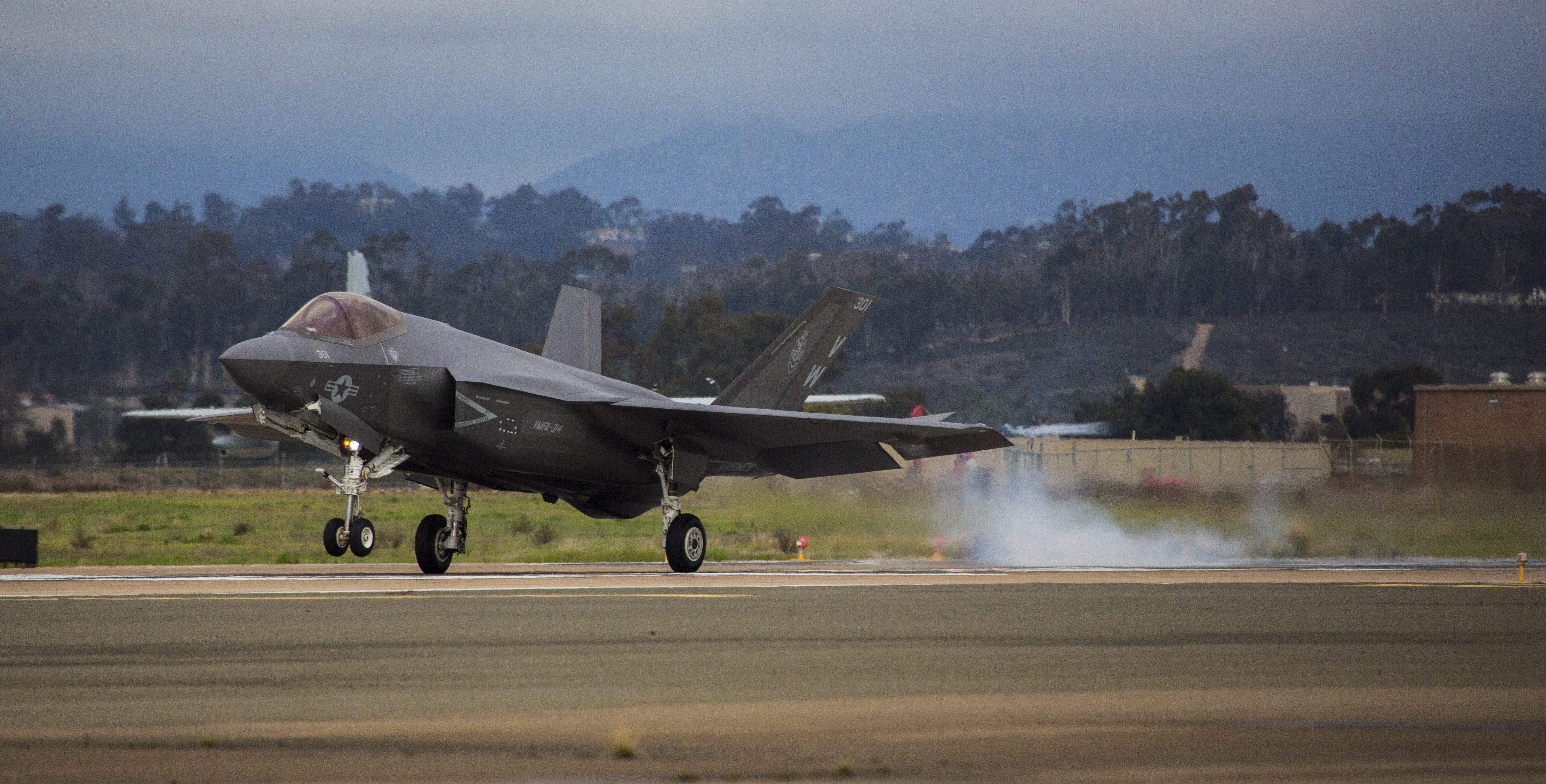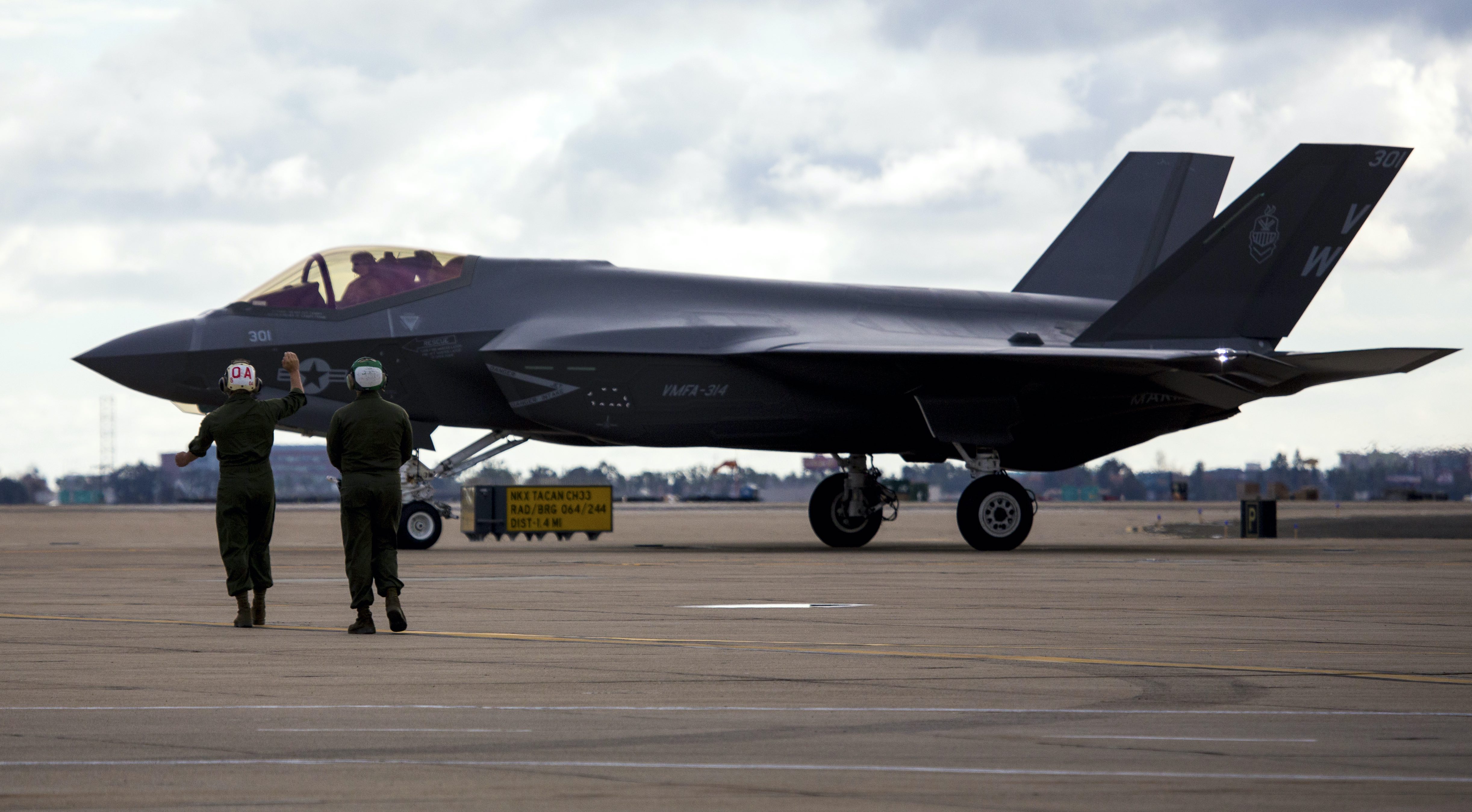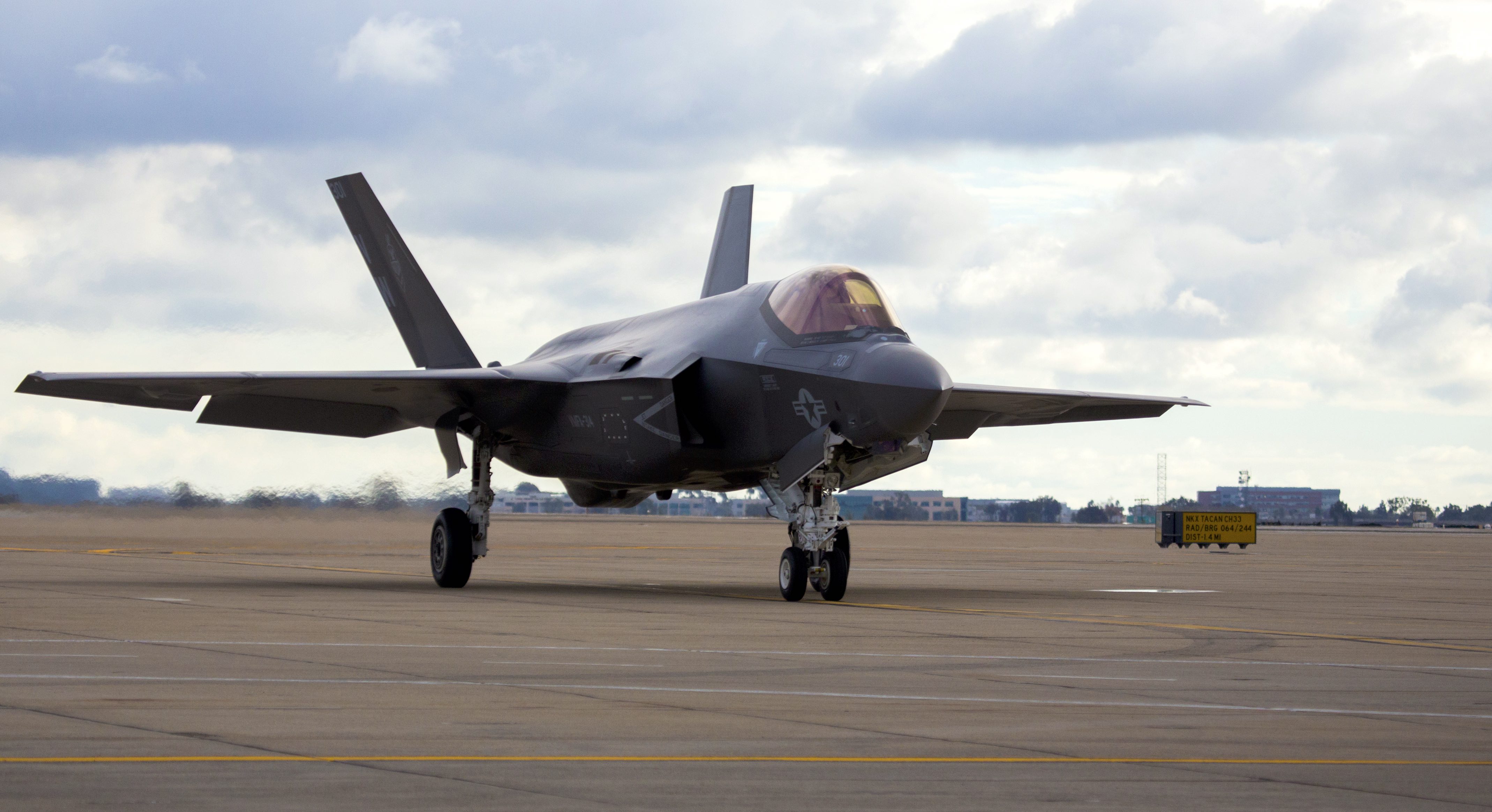
SAN DIEGO, Calif. — The Marine Corps’ first squadron of F-35C Joint Strike Fighters will reach an initial operating capability next month ahead of future carrier deployments, officials said Friday.
The second F-35C Lightning II belonging to Marine Fighter Attack Squadron 314 arrived Friday at Miramar Marine Corps Air Station, Calif., ten days after the first jet arrived in San Diego.
“We will get our third airplane here shortly,” Maj. Gen. Kevin Iiams, the commander of the Miramar-based 3rd Marine Aircraft Wing, told USNI News. “And we are on track to establish our safe-for-flight operations – i.e., our ability to conduct operations just with 314 and no external support – probably by the end of March.”
Iiams was speaking Friday during an F-35 “open house,” where 3rd MAW and F-35-manufacturer
Lockheed Martin officials introduced the new jet to local community leaders. The “Black Knights” of VMFA-314 brought their first two F-35C jets from Lemoore Naval Air Station, Calif., where aircrews and maintainers have been working alongside Navy personnel since last summer for transitioning to the new jet.
“The other airplanes start arriving very soon after that,” Iiams said. “So, we will get airplanes all through throughout the summer and we should have our full complement of 10 airplanes by this fall. They will get right into their training cycle to get combat-ready, and then they will step into their pre-deployment cycle for the carrier. So they will be the second F-35 squadron, ever, aboard a carrier.”
VMFA-314, a former F/A-18 Hornet jet squadron, “is set to deploy most readily, real soon, aboard our aircraft carriers,” Iiams said.
The first carrier-based F-35 unit to deploy will be the Navy’s Strike Fighter Squadron 147, the “Argonauts.” Navy officials have said 147 will deploy aboard USS Carl Vinson (CVN-70) in 2021. VMFA-314’s carrier deployment is slated to occur in fiscal 2022, according to the Marine Corps’ 2019 Aviation Plan.
Iiams, a veteran F/A-18 pilot, said the F-35 represents “a revolutionary leap forward.” The Lightning II replaces the older jets, including the single-seat F/A-18C Hornets that VMFA-314 flew for the final time last summer. “In the past week, those legacy platforms fade into the ether, and we step out with the F-35 into the light of the next-generation platform. Miramar is going to be right there with us,” he added, noting the air station’s “strategic location comparable to no other.”
Miramar is the planned home for six of 3rd MAW’s scheduled 10 F-35 squadrons – two F-35C and four F-38B squadrons, with the other four based at MCAS Yuma, Ariz., according to the Marine Corps’ 2019 Aviation Plan. Basing the F-35Cs at Miramar puts the jet close to the Navy’s carrier homeport, where Vinson will join USS Abraham Lincoln (CVN-72) and USS Theodore Roosevelt (CVN-71). Being at Miramar also puts the F-35Cs in the middle of the Navy’s vast complex of air, sea and ground ranges across the Southwest and offshore.
“Our adversaries continue to develop surface-to-air missiles and stealth fighters. We must keep up our efforts to maintain air superiority with our defense readiness capabilities, and we are,” said Rep. Scott Peters, D-Calif., whose district includes seven major Marine Corps and Navy installations. “These F-35 aircraft will be critical to deploy to military missions around the world. They are the world’s most advanced fighter.”
The three carriers homeporting in San Diego “will provide plenty of deck space” and support training for the F-35Cs, Peters said.
The Marine Corps continues to divest its older platforms. The EA-6B Prowler electronic warfare jet flew its final flight last year. The AV-8B Harrier jump jet continues to operate with detachments deploying overseas, as well as a training squadron. Still, the five active squadrons will be entirely replaced by the F-35B vertical/short takeoff and landing variant in fiscal 2028, according to current plans.
Iiams praised the F-35 for its “true, unmatched, game-changing technology advancement in every domain” and noted its array of sensors, low-observability and stealthy characteristics. “This aircraft will enable seamless integration exchanges with platforms, both on the surface, subsurface, air and space, making every warrior in the battlespace, every asset in the battlespace, more lethal, more survivable and smarter than we have been before,” he said, adding “we can enter hostile airspace undetected, strike targets and establish maritime and air dominance at the time and place of our choosing.”
Marine-Navy Integrated Training

Since July 2019, VMFA-314 Marines took their F-35C with them to Lemoore NAS on temporary duty for several months “and then came home,” Iiams said. “Their families remained here as the Marines moved up there and gained their training. Now their Navy counterparts have moved back here to continue that training for about the next three months until we’re able to meet our initial operating capability. So they’re going to ensure we are able to sign our airplanes off as safe for flight, all of our maintenance programs have been developed and we are fully qualified to operate the F-35.”
The Navy squadrons remain responsible for the jets until the Marines are fully qualified. “It’s been phenomenal. The Navy has gone above and beyond in making sure that our Marines have the highest level of training,” Iiams said. “We integrated instructors. We integrated aircraft. They let us bring up our pilots and our maintainers to train with them. Those Marines are returning, and the small Navy contingent are here “to mentor us and make sure we’re on the right track.”
“All of our F-35C pilots just carrier [qualified] with the Navy training squadron. So as they come home, they are fully qualified, F-35C carrier-capable pilots,” Iiams said. “I think it just speaks volumes that this teaming concept of the Navy and Marine Corps is going to accelerate us into this next-generation platform.”
One of those pilots is Lt. Col. Brendan Walsh, who is VMFA-314’s executive officer and one of the six pilots who just got their CQs aboard USS Nimitz (CVN-68). Walsh, a former F/A-18C pilot and carrier veteran told USNI News the Lightning II simplifies, to a degree, the complicated process of landing a fighter jet on the deck of a carrier moving in the sea.
The F-35C “flies probably better than the Hornet off the ship…with some of its autopilot modes,” he said. “Here, they want you to have hands-off and only correct if you feel it settle, so you’re essentially hands-off on takeoff.”
For landing on the carrier, “this airplane solves multiple variables for you,” Walsh said. “Whereas in the F-18 you could be manually flying your throttle position, your glide slope, your power for your rate of descent and now reacting to what the ship is doing. In this airplane, you can have your angle of attack, you can have your glide slope automatically set and your speed automatically set. In the F-18, you were constantly making three-part corrections for any deviation you saw for landing on the ship. In the F-35, it’s really just, ‘I’m confirming that I’m good and maybe just making a one-part correction.’”
Training helps build the muscle memories, especially initially for a pilot transitioning from another aircraft, like the Hornet. “On the catapult shot, you kind of get thrown backwards. On the F-35, you get punched up in the air a little bit with the shock of the catapult,” said Walsh, who had 250 hours in the Hornet before he transitioned to fly the F-35B and recently the F-35C.
Flying the ball “is easier,” he added. “You still need to react to the ship if there are any course corrections or a pitching deck.”
And some habits must be shed when flying the new aircraft. Former Hornet pilots now flying the F-35C, have to shake the tendency to push the throttle at trapping. Walsh said he had pushed the throttle in the Hornet during trapping in the event a bolter was needed.
Touch-and-goes on the ship help build up the trapping confidence, Walsh said. He has flown the F-35 for eight years, with 930 flight-hours including getting F-35B-qualified on the Navy’s LHD and LHA amphibious assault ships,
New Fighter in Miramar Skies

The F-35C squadron has made a home in Hangar 1 at Miramar, where construction continues on an F-35 training simulator building.
The F-35C’s arrival brings a new type of aircraft to the skies around the air station, which sits in San Diego city’s northern suburbs. “This has been a long time coming,” said Col. Charles Dockery, the Miramar MCAS commander and a veteran F/A-18D Hornet pilot.
Flight operations of the F-35C will follow existing flight paths at and around Miramar, whose airspace is part of the larger and busy “Class B” airspace in southern California. Miramar is the largest runway south of Los Angeles International Airport, officials said.
Flight paths won’t change, air station officials said. Miramar released maps detailing the “footprint” of noise and accident potential zones in a 2020 update to the MCAS Miramar Air Installations Compatible Use Zone Study, which details accident potential zones and restrictive use easements for local and regional government.
Continued development and population growth in the surrounding areas, however, has put more pressure on regional military leaders and local officials grappling with long-running concerns over encroachment, flight paths and noise.
The Defense Department AICUZ program recommends preventing land-use measures and development that are incompatible with military operations. “There are no significant changes from 2005,” the last time the study was updated, Dockery said.





